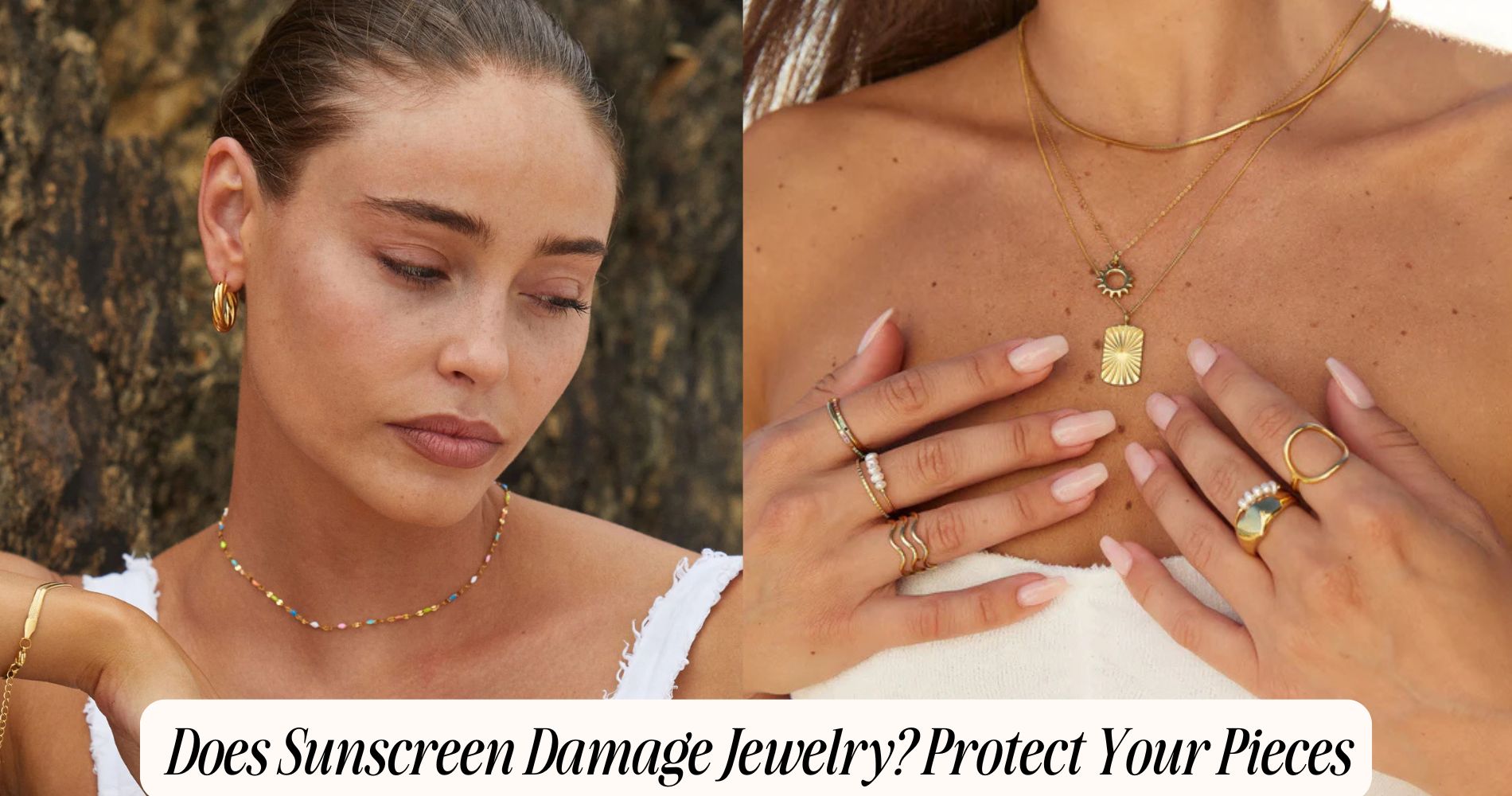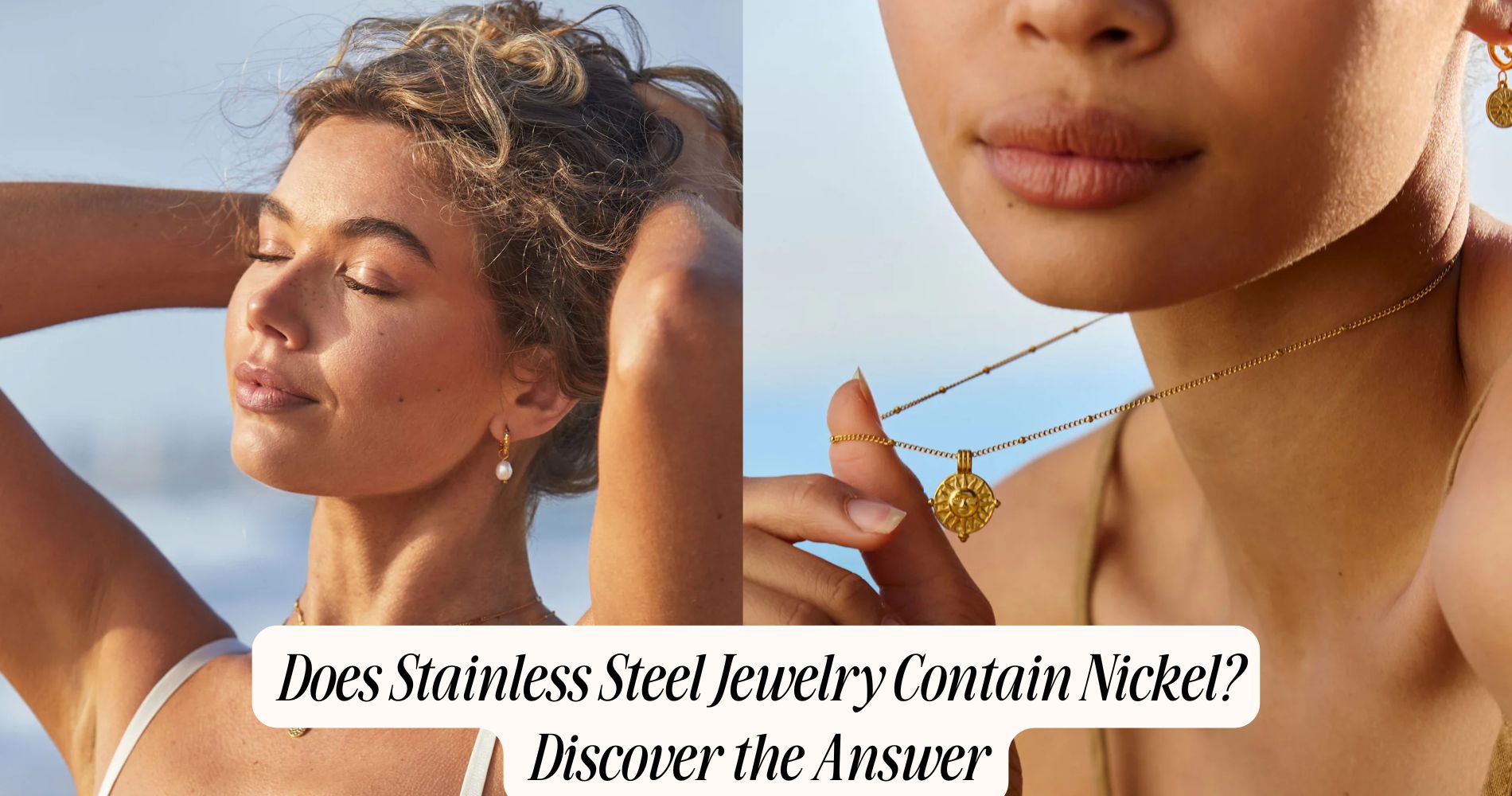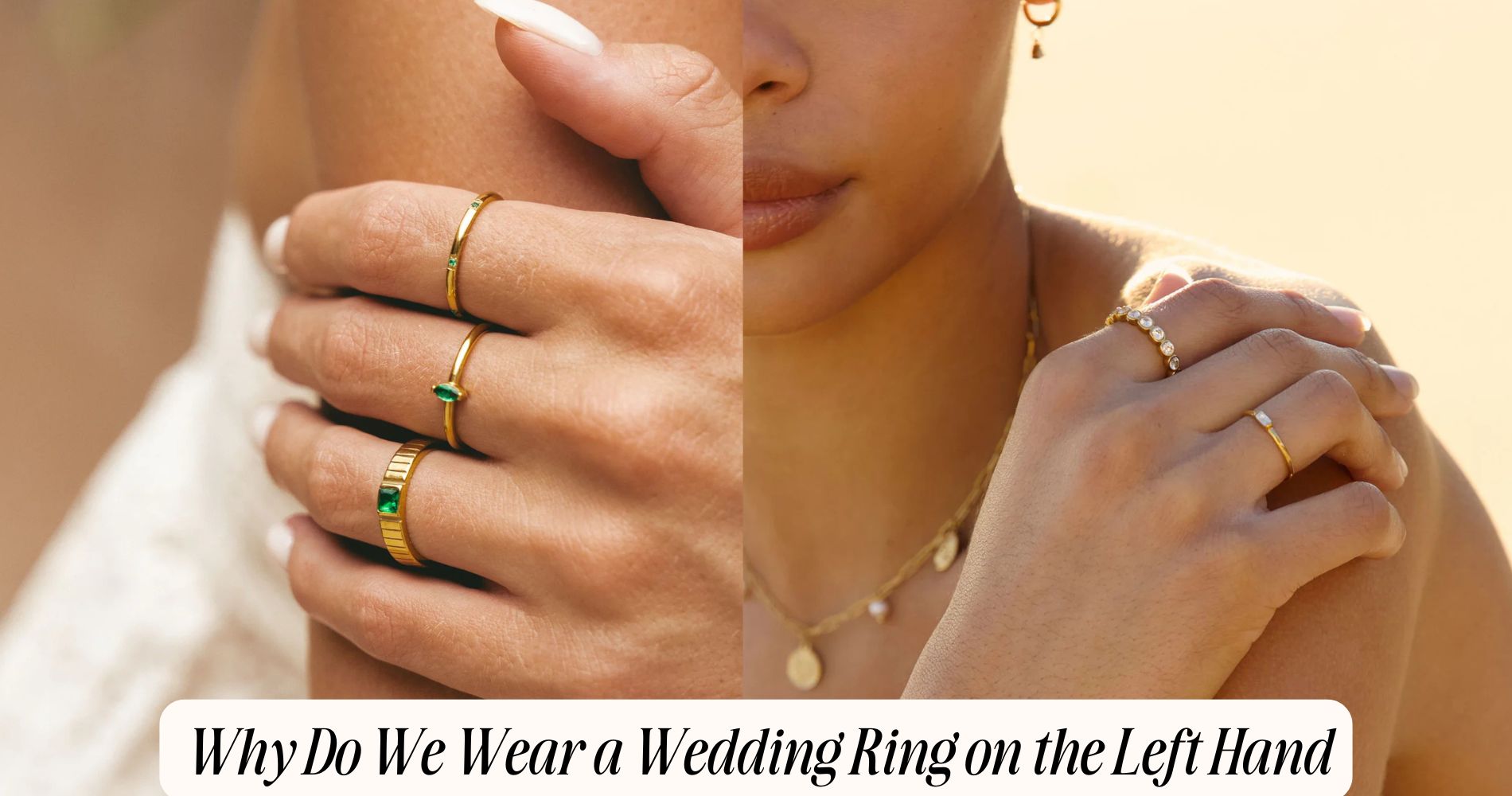
Does Sunscreen Damage Jewelry? Protect Your Pieces
Does sunscreen damage jewelry? Yes, it can. The active ingredients in chemical sunscreens often tarnish metals and degrade gemstones, particularly softer stones like pearls and opals. Sunscreen residue can lead to discoloration, dullness, or unexpected hues on your jewelry. To protect your pieces, opt for mineral-based sunscreens or natural oils with SPF. Cleaning your jewelry with mild soap and water after exposure is also essential. Regular inspections and proper storage will help maintain its beauty. For pieces designed to withstand skin sensitivities and harsh chemicals, check out our Hypoallergenic Jewelry Collection.
Understanding Sunscreen Ingredients
Understanding sunscreen ingredients is essential for effective sun protection and skin health. When you choose a sunscreen, you're looking at its formulation, which typically includes active and inactive components. The active ingredients, like zinc oxide or avobenzone, provide the UV protection you need, while inactive ingredients help with application and skin feel.
It's vital to opt for a broad-spectrum sunscreen that shields against both UVA and UVB rays. Pay attention to the formulation because some ingredients can affect your jewelry. For example, chemical sunscreens may contain compounds that can tarnish metals or degrade certain gemstones over time.
If you wear jewelry frequently, consider a mineral-based sunscreen, as it tends to be gentler on both your skin and your accessories. Incorporating good jewelry care practices is just as important as choosing the right sunscreen. Always apply your sunscreen first and allow it to absorb before putting on your jewelry.
This way, you can protect your skin while minimizing the risk of damaging your beloved pieces. By understanding sunscreen ingredients and their implications, you can enjoy the sun safely without compromising your jewelry's integrity.
How Sunscreen Affects Different Metals
Sunscreen can have a significant impact on various metals used in jewelry, particularly when it comes to their longevity and appearance.
The sunscreen composition typically includes oils, chemicals, and fragrances that can react negatively with certain metals. For example, silver is prone to tarnishing when exposed to these substances, diminishing its shine and luster.
Similarly, gold-plated jewelry can lose its coating more quickly due to the corrosive effects of sunscreen, leading to unsightly wear.
If you wear jewelry while applying sunscreen, it's crucial to practice proper jewelry maintenance. Rinse your pieces with mild soap and water after sun exposure to remove any residues.
For sterling silver, consider using a polishing cloth to restore its brilliance. Stainless steel, while more resilient, can still be affected by prolonged exposure, so regular cleaning is advisable.
Understanding how sunscreen impacts different metals will help you preserve your jewelry's beauty and durability.
Impact on Gemstones and Pearls
When you apply sunscreen, its chemicals can interact with gemstones and pearls, potentially leading to damage.
Residue left on these precious materials can cause discoloration or even deterioration over time.
To protect your jewelry, it's important to clean it properly after exposure to sunscreen.
Chemical Reactions With Gemstones
Chemical reactions with sunscreen can frequently impact the beauty and integrity of gemstones and pearls. Many gemstones possess varying degrees of sensitivity to chemicals, meaning that exposure to sunscreen can lead to discoloration, dullness, or even structural damage.
For instance, softer stones like opals and pearls are particularly vulnerable. The oils and chemicals in sunscreen can penetrate their surfaces, causing unsightly blemishes.
When you're applying sunscreen, it's essential to take into account the composition of your jewelry. Some gemstones, like turquoise and malachite, are porous and can absorb chemicals, which may lead to irreversible damage.
Even harder stones, such as diamonds, can experience dullness from these chemical reactions if not properly cleaned afterward.
For the best protection, always remove your jewelry before applying sunscreen. If you do accidentally expose your gemstones to sunscreen, rinse them gently with lukewarm water and mild soap as soon as possible.
Pearls and Sunscreen Residue
Exposure to sunscreen residue can have detrimental effects on pearls, which are particularly sensitive to chemical substances. When you apply sunscreen, the oils and chemicals can easily transfer to your jewelry, especially if pearls are in close contact with your skin. This residue can lead to discoloration, dullness, and even a breakdown of the pearl's nacre, diminishing its luster and beauty.
To protect your pearls, it's essential to practice proper pearl care. Always apply sunscreen well before putting on your jewelry, allowing it to fully absorb into your skin. If you inadvertently get sunscreen on your pearls, gently clean them with a soft, damp cloth to remove any residue. Avoid using harsh chemicals or cleaners, as they can further damage your pearls.
Additionally, consider removing your pearl jewelry before applying sunscreen, swimming, or engaging in outdoor activities. By taking these simple precautions, you can enjoy your time in the sun while keeping your pearls safe from the harmful effects of sunscreen residue.
Signs of Jewelry Damage
You should keep an eye out for signs of jewelry damage, as they can indicate the need for repair or replacement.
Discoloration and stains on your gemstones, scratches and scuffs on metal surfaces, and signs of corrosion can all compromise the integrity of your pieces.
Regular inspections can help you catch these issues early, ensuring your jewelry remains in top condition.
Discoloration and Stains
How can you tell if your jewelry is suffering from discoloration or stains? Look closely for any changes in color or unsightly marks. Discoloration often appears as a dulling of shine or an unexpected hue, which can be caused by a variety of factors, including exposure to chemicals in sunscreen.
These substances can create an unwanted reaction with metals, leading to tarnishing and fading.
Stains might manifest as dark spots or residues on your pieces, particularly in areas that come into contact with your skin. This is especially common in jewelry made from porous materials, like pearls or certain gemstones, which can absorb oils and lotions.
If you notice these signs, it's essential to act quickly.
For stain removal, gently clean your jewelry with a soft cloth and mild soap solution. Avoid harsh chemicals that could exacerbate discoloration.
Regular maintenance, including proper storage and cleaning, will help prevent long-term damage. If you're unsure, consult a professional jeweler for advice on restoring your valued pieces.
Staying vigilant against discoloration and stains will keep your jewelry looking its best.
Scratches and Scuffs
Scratches and scuffs can greatly detract from the beauty of your jewelry, often making even the finest pieces look worn and neglected.
During sunscreen application, it's easy to overlook the potential harm to your jewelry. Sunscreen contains chemicals and oils that can exacerbate the damage caused by everyday wear, especially when paired with physical activity.
To guarantee effective jewelry protection, consider removing your pieces before applying sunscreen. This simple step can help prevent unwanted scratches from occurring due to friction between your jewelry and your skin or clothing.
Additionally, be mindful of how you store your jewelry. Keeping it in a soft-lined box or pouches can minimize the risk of scuffs and scratches when not in use.
If you notice any existing damage, addressing it promptly can help maintain your jewelry's aesthetic. Professional cleaning and polishing can often restore its original shine.
Paying attention to these details during sunscreen application and daily wear can help you enjoy your jewelry longer, preserving its beauty and value.
Metal Corrosion Signs
Even with careful handling, jewelry can still suffer from damage, particularly metal corrosion, which is a common issue that may go unnoticed until it becomes significant.
One of the first signs of metal oxidation is discoloration; you might notice a dull sheen or dark spots on your pieces. This could indicate that the metal is reacting with moisture or chemicals, often found in sunscreen or lotions.
Another sign to watch for is pitting or small holes forming on the surface of the metal. If you see this, it's important to address it immediately, as it can lead to further deterioration.
Additionally, you might find that your jewelry has become brittle or has lost its luster, making it feel less substantial than before.
To prevent these issues, regular jewelry maintenance is vital. Clean your pieces frequently with a gentle solution and dry them thoroughly after exposure to sweat or chemicals.
By being proactive, you can minimize the risk of metal corrosion and guarantee your jewelry remains beautiful and intact for years to come.
Always keep an eye out for these signs to protect your treasured items effectively.
Preventative Measures for Jewelry
Protect your jewelry by taking simple yet effective preventative measures. First, verify you practice preventive storage. Store your pieces in a cool, dry place, away from direct sunlight and humidity. Use soft pouches or lined boxes to prevent scratching and tangling. This approach minimizes exposure to elements that can cause deterioration.
Next, schedule regular inspections of your jewelry. Check for signs of wear, such as loose stones, worn clasps, or scratches. By identifying issues early, you can address them before they become serious problems. A simple inspection can save you from costly repairs or the loss of a beloved piece.
Additionally, consider limiting exposure to substances like sunscreen, lotions, and perfumes before putting on your jewelry. These products can build up on your pieces, leading to discoloration or damage over time.
Lastly, always clean your jewelry after wear. Use a soft cloth to wipe away any residue and keep your pieces looking their best.
Best Practices for Wearing Jewelry
When it comes to wearing jewelry, timing and occasion play essential roles in maintaining its beauty and integrity. You should reflect on when and where you'll wear your pieces to protect them from potential damage. For instance, if you're spending the day at the beach, opt for simpler designs that can withstand sand and saltwater exposure.
Utilizing jewelry layering techniques can also enhance your look while ensuring individual pieces remain safe. If you choose to layer, use different lengths and materials to avoid tangling and scratching. Be mindful of how your jewelry interacts; metals can tarnish or scratch each other if stacked carelessly.
Seasonal jewelry choices are another significant aspect to reflect on. In summer, lightweight materials like sterling silver or colorful beads can bring vibrancy without compromising durability. During colder months, you might select more substantial pieces that can withstand heavier clothing.
Ultimately, being intentional with your jewelry choices and mindful of the conditions in which you wear them will help preserve their beauty and longevity. By following these best practices, you can enjoy your jewelry collection to the fullest while minimizing wear and tear.
Cleaning Jewelry After Sunscreen Use
After a day in the sun, it's vital to clean your jewelry to remove any sunscreen residue that can lead to dullness or damage. The right cleaning methods will guarantee your pieces maintain their shine and integrity.
Start by rinsing your jewelry under lukewarm water to wash away any loose sunscreen particles. For most metals and gemstones, a gentle soap solution works wonders. Mix a few drops of mild dish soap with warm water, then dip a soft cloth or a soft-bristled toothbrush into the solution and gently scrub your jewelry.
Pay special attention to intricate designs where residue can accumulate.
After cleaning, rinse your pieces thoroughly under lukewarm water to remove any soap. It's important to dry your jewelry properly; use a soft, lint-free cloth to wipe away moisture.
For added jewelry maintenance, consider using a jewelry polishing cloth to restore any lost shine.
Alternatives to Traditional Sunscreen
Sunscreen isn't the only option for shielding your skin from harmful UV rays; there are several effective alternatives worth considering.
Natural sunscreen alternatives can provide protection without the synthetic chemicals often found in traditional products. For instance, oils like coconut, jojoba, and raspberry seed have naturally occurring SPF properties. While these oils may not offer the same level of protection as commercial sunscreens, they can be a great addition to your sun safety routine.
Another option is mineral sunscreen. Unlike chemical sunscreens that absorb UV rays, mineral options contain active ingredients like zinc oxide or titanium dioxide, which physically block UV radiation.
These mineral sunscreen options are often recommended for sensitive skin, as they're less likely to cause irritation. They also don't contain the same harsh chemicals that can damage jewelry, making them a safer choice for your accessories.
Whichever alternative you choose, be sure to reapply regularly, especially after swimming or sweating.
Frequently Asked Questions
Can Sunscreen Cause Discoloration on Gold Jewelry?
Yes, sunscreen can cause discoloration on gold jewelry due to certain ingredients. For effective gold jewelry maintenance, always apply sunscreen and let it dry before wearing your pieces to minimize any potential damage.
Is It Safe to Wear Costume Jewelry While Using Sunscreen?
Wearing costume jewelry while using sunscreen is generally safe, but be cautious. Sunscreen ingredients can sometimes cause discoloration. For ideal costume jewelry care, avoid direct contact and clean your pieces regularly to maintain their appearance.
Do Different Sunscreen Brands Affect Jewelry Differently?
Different sunscreen brands can indeed affect jewelry differently. Varying sunscreen ingredients may cause distinct jewelry reactions, potentially leading to tarnishing or discoloration. Always check product labels to minimize any adverse effects on your precious pieces.
How Often Should I Clean Jewelry Exposed to Sunscreen?
You should clean jewelry exposed to sunscreen at least once a week to maintain its shine and prevent buildup. Regular cleaning frequency is essential for effective jewelry maintenance, ensuring your pieces stay beautiful and unharmed.
Can Sunscreen Lead to Tarnishing on Silver Jewelry?
Yes, certain sunscreen ingredients can lead to tarnishing on silver jewelry. To maintain your pieces, prioritize regular silver care, avoiding prolonged exposure to these products. Clean your jewelry after use to minimize potential damage.
Conclusion
To protect your jewelry from potential damage caused by sunscreen, it's essential to understand the ingredients and their effects on different metals and gemstones. By taking preventative measures, like applying sunscreen before putting on your jewelry and cleaning your pieces afterward, you can preserve their beauty. Consider exploring alternatives to traditional sunscreen that are less damaging. With these practices, you can enjoy your time in the sun while keeping your jewelry safe and shining bright.

























Leave a comment
This site is protected by hCaptcha and the hCaptcha Privacy Policy and Terms of Service apply.